

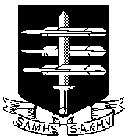 The South African
The South African
Newcastle town cemetery is an unlikely place to find an elaborate memorial, that was the gift of a Royal princess, over a neglected grave in a scruffy burial ground. The cemetery was established during the infancy of the town in the 19th century. Newcastle became an important coal mining centre in the 1890's. The growing port of Durban and its surrounding industry and farming needed coal for the shipping calling there and for the factories and sugar mills along the coastal plains.
The cemetery is a short distance off the main street of the town, at the end of York Road. Some trees were planted on the site, inevitably some exotic cedars and poplars. After more than a century they provide abundant shade and shelter. The major consideration for the town authority's choice of resting place for their deceased inhabitants was that the site was flat and even and with soft soil.
Most of those interred there were local people, but some casualties from the Anglo Boer War (ABW) occupy a corner as a Garden of Remembrance. Above a number of the graves there once were the metal crosses of the military with just a name plaque riveted to the metal. Many of these, sadly, have been removed and recycled as scrap metal. Some others are of marble with an engraved plinth - if their family was able to arrange such a memorial for their loved one.
There are numbers of sources listing ABW casualties. One of the most interesting and informative is The Last Post by Mildred Dooner. Published in 1903, it is a comprehensive listing of all the Imperial officer fatalities, giving name and rank, some detail of how and where they were killed, and their burial place. David Scholtz, current chairman of the SA Military History Society, has made it one of his life's tasks to investigate each and every one and, if possible, to visit their grave site.
One entry in Dooner is of a doctor, one Major George Hilliard of the R.A.M.C. (Royal Army Medical Corps). He is described by Dooner as follows:
Nigel Mason located the grave with some difficulty. It was in the row of officers' graves which lies outside the military area. A visit to the cemetery by Nigel with David and his brother Peter found one memorial very different from the other tombstones. It took the form of a red granite plinth surmounted by a broken column with the letters IHS. IHS are the first three letters of the name 'Jesus' in Greek. This is Iota (I), Eta (H in capitalised form in Greek), Sigma (S). It is sometimes written IHC (the version of the capital letter at the end of a word is C) and may include a bar over the H to indicate an abbreviation. The brass plaque on the plinth had been stolen, so there was no way of knowing for certain that this was the memorial gifted by Princess Henry, although that seemed the obvious deduction. But a page from the British Medical Journal of the 11th of May 1901 proved conclusively that the memorial in question was indeed that sent out by Princess Henry:
PRINCESS HENRY OF BATTENBERG has just sent out to South Africa a monument to be placed over the grave of the late Major George Hilliard, R.A.M.C., who died at Newcastle General Hospital, Newcastle, on September 7th from wounds received in the reconnaissance at Ingogo on September 5th. The memorial consists of a broken column and moulded base of Aberdeen granite, 5 feet high, the shaft being adorned with a Latin cross upon which the letters "I.H.S."are carved. The dedicatory brass bears the following inscription:
Sacred to the memory of Major George Hilliard, R.A.M.C., who died at Newcastle, September 7th, 1900 from wounds received in a reconnaissance near Ingogo on the 5th.
Erected in grateful remembrance of the devoted care he rendered her husband by Beatrice, Princess Henry of Battenberg.
(The British Medical Journal - Vol I No 2106, May 11th 1901, page 1163.)
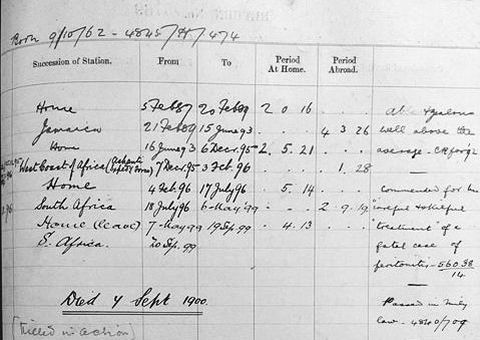
A page taken from Hilliard's service record showing his
travels to Jamaica, the West Coast of Africa (Ashanti)
and South Africa twice, interspersed with Home (UK) visits.
Curved around the plinth there was originally a handsome brass plaque. This has long since fallen victim to looters looking for valuable scrap metal.
David Scholtz and his brother Peter have a particular interest in the war graves of the ABW. David undertook to restore the monument and clean up the grave site. A brass plaque was impractical as it would simply suffer the same fate as the original. Newcastle Granite Works undertook to make and install another plaque from granite which would protect it from vandals. It needed to be shaped so as to wrap around the curved plinth.
The weeds were removed from around the base and the gravel covering the grave itself was raked and smoothed. Some little while later the grave itself was given a granite slab with the full description from the BMJ engraved upon it. This is how it stands today, now a fitting memorial to a brave man who earned the gratitude of a Royal Princess.
Hilliard was promoted Major only on 5th February, 1899. His army record shows that he served in Britain and Jamaica before his short time with the Ashanti Expedition, when he was charged with the care of Prince Henry. He came to South Africa and was present at the Matabele Campaign in 1896. Back in Britain for a short spell, he was sent to South Africa just before the outbreak of war in September 1899 and stationed in Ladysmith. Once the siege was lifted he moved with the advance to Newcastle where he suffered a gun-shot wound to the abdomen while on reconnaissance at Ingogo, as indicated in Dooner and his service record.
His army record seems to indicate that he was destined for high rank. There is a note to the effect that he was 'an able and efficient officer with professional attainments of a high order and a thorough knowledge of his duties' and further 'possesses abilities of a very high order'. He is commended for his 'careful and [illegible] treatment of a fatal case of peritonitis'. Another comment on his record says that he 'able and zealous, well above average'.
Hilliard's service record also includes this: 'Queen's thanks expressed to Capt Hilliard for service he rendered to H.R.H. the late Prince Henry of Battenberg during fatal illness acquired by the latter with Ashanti Field Force'. The Queen must have written a letter to Hilliard or, more likely, to the R.A.M.C. but the whereabouts of the letter are unknown.
The Ashanti Expedition of 1895-96 was short-lived - from 26 December 1895 to 4 February 1896. The object was to chastise King Prempeh I of the Ashanti. Treaty arrangements with the Ashanti dated from Major-General Sir Garnet Wolseley's expedition of 1873-4 when missionaries, held hostage, were freed. The Ashanti capital, Kumasi, was burnt and the ensuing treaty put an end to human sacrifice, and slave trading was no longer permitted. An indemnity of 50,000 ounces of gold was levied but not paid by the Ashanti. A road was built from the coast to Kumasi, 250 kilometres inland. In 1895-96 another expedition was organised under the command of Major-General Sir Francis Scott to ensure compliance with the earlier treaties. This time there was no fighting, King Prempeh was exiled to Sierra Leone, and matters were settled in six weeks. There were no British battle casualties but fifty per cent of the troops fell ill in the unhealthy climate.
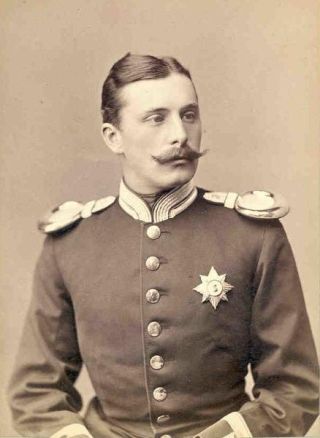
Prince Henry of Battenberg
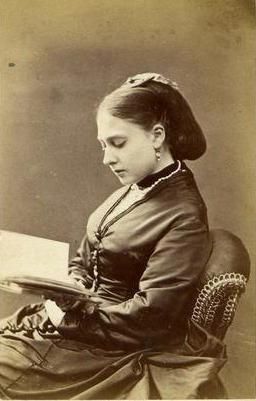
Beatrice, Princess Henry of Battenberg
Among them was Prince Henry of Battenberg, husband of Princess Beatrice, youngest daughter of Queen Victoria. He was to join the expedition with the rank of Colonel but had no official duties. The Illustrated London News sent its correspondent H.C. Seppings Wright to the Gold Coast. On arrival at Cape Coast Castle, one of the coastal strongholds:
"There I saw Prince Henry of Battenberg ... at a breakfast to which I had been invited by Prince Christian. Soon we set out for Coomassie, which is about 150 miles further inland. Not a long journey perhaps but altogether unforgettable. After you have tramped that road, through the dark, dingy forest, with its rotting luxuriant vegetation, its fetid swamps and its humid atmosphere you will have some idea of what Bunyan's pilgrims experienced in the Slough of Despond. Here and there, it is true, comes a clearing, like glimpses of a promised land, but hope is short-lived, for the traveller soon has to plunge back into the fatal forest where fever lurks at ever footstep. It is in short a journey in the Valley of the Shadow of Death. And yet it was with good spirits that the little army, some 1200 strong, set out from the coast for the capital of Prempeh's dominions. The extraordinary difficulties of travel may be gauged from the fact that we were accompanied by some 10,000 carriers, hardy specimens of the natives and inured by practice who have been equipped by nature to withstand the rigours of the country'.
Seppings Wright also described when Prince Henry and Prince Christian dined the Press Gang and a 'right merry night we had of it'. Prince Henry evidently had armed himself with a Remington-Elliot .32 'Pepperbox' revolver with which he practiced regularly. The Prince showed his pluck, said Seppings Wright, when a 'riot broke out among our carriers. He went boldly down among the combatants, his shirt sleeves rolled up, and a look on his face of a man who was not to be trifled with. One hapless wretch was being belaboured to death by his infuriated fellow-carriers and the Prince rescued him from the ghastly scrimmage and brought him to Surgeon-Captain Hilliard to be bandaged'.
When still three days from Kumasi Prince Henry fell ill with malarial fever andthe decision was taken to return him to the hospital ship Coromandel lying off Cape Coast Castle:
(The British Medical Journal - Vol I No 2106, May 11th 1901, page 1163.)
His wife, Princess Henry of Battenberg, had intended sailing to Madeira in the Royal Navy cruiser H.M.S. Blenheim to meet him there. She was confronted with the sad news that he had died at sea, thus she did not actually sail. His remains were transferred to the warship and together with Hilliard sailed back to Portsmouth. There the coffin was transferred to the Queen's yacht, the Alberta, and carried to Osborne House on the Isle of Wight. The Prince was buried at St Mildred's Church, Whippingham, just a short distance from Osborne House. Princess Beatrice's remains were likewise placed there, re-interred from Windsor, where she had been buried when she died in August 1944.
On the same day as the funeral, or possibly some days later, Surgeon-Capt, George Hilliard, was 'introduced to Her Majesty's presence by Equerry Sir Fleetwood Edwards, when the Queen invested him with the insignia of a Companion of the Order of St Michael and St George. The Order is awarded to those who hold high office or who render extraordinary or important non-military service to the United Kingdom in a foreign country. At that time, it was reported that both the Queen and Princess Beatrice had made known their appreciation of the efforts of Surgeon- Captain Hilliard to save the life of Prince Henry of Battenberg.
Beatrice, Princess Henry of Battenberg, Queen Victoria's ninth child and fifth daughter was born in 1857 and was only four when her father, Prince Albert died on 14 December 1861. The Queen relied on Beatrice since all her older sisters had married and left their mother. The Queen was opposed to her marrying but nevertheless a number of suitors were put forward, including Louis, the Prince Imperial, son of the exiled Napoleon III, who was killed in the Anglo-Zulu War in 1879. She finally relented and gave her consent for Beatrice to marry the German Prince Henry of Battenberg, with the proviso that they make their home with her at Osborne. They were married in St Mildred's Church in Whippingham.
Prince Henry was made a Knight of the Garter shortly before the marriage. In 1889 he was given the position of Governor of the Isle of Wight and by 1893 was a colonel in the British Army. He constantly hankered to go on active service and Victoria finally relented and permitted his appointment as military secretary to the commander of the Ashanti expedition, Sir Francis Scott. He met has death as a result, as related.
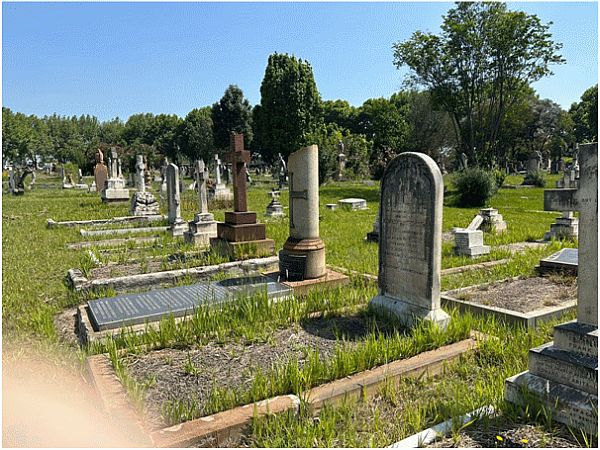
View of officers' graves circa 1910.
Hilliard's is second from left in main row.
This colour photograph appeared on the
inside back cover of this issue.
After a short spell in England, Hilliard went to South Africa and was involved in the Matabele Campaign in 1896, spending a little more than two years in what was then Rhodesia. Back home for little more than a month and promoted to Major, he returned to South Africa in September 1899 just before the outbreak of the Anglo Boer War. He joined Sir George White's Natal Field Force and, when the siege of Ladysmith was lifted, moved to Newcastle. A small garrison had been left in that town as the bulk of General Redvers Buller's army had, by September 1900, moved into the eastern Transvaal. There were still a few Boers in the vicinity and daily patrols kept them from becoming too troublesome. It was on one of these patrols that Hilliard was shot in the abdomen. Survival from such a wound was problematic in those days and after three days he succumbed to his wound in the Newcastle General Hospital. He was buried in Newcastle Town Cemetery, with a metal cross and his name stamped onto a metal plate riveted to the cross, until in 1901 Princess Beatrice's handsome monument was erected over the grave. The telegrams that she received regularly about the progress of the Anglo Boer War informed the Queen of Hilliard's death. She always took a great interest in the British Army and their operations and broke the news to her daughter as gently as she was able. She it was who told Prince Christian Victor, son of Princess Helena, one of Beatrice's elder sisters, and therefore Prince Henry's cousin, of the death of Major Hilliard. In September 1900 he was in Pretoria on the staff of Commander in Chief, Lord Roberts. He would have had access to the casualty returns and would have seen Hilliard's name. Prince Christian Victor had also been on the Ashanti Expedition of 1896, Seppings Wright describes the 'right merry night we had of it' with the two Princes so they were more than just nodding acquaintances. They surely knew one another as fellow family members. Prince Christian would also have known of Hilliard's care of Prince Henry and would surely have sent condolences to his wife.
The grave, it can be told, is still pristine.
About the Author
Robin Smith is a frequent contributor to the Military History Journal and also a regular lecturer at the Society's Zoominars.
His interests range far and wide as proved by the variety of articles in the Journal library, the Zoom Video library andnewsletter reports of in-person lectures, all to be found on the website.
Return to Journal Index OR Society's Home page
South African Military History Society / scribe@samilitaryhistory.org